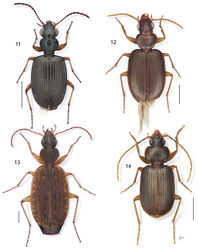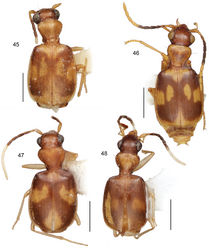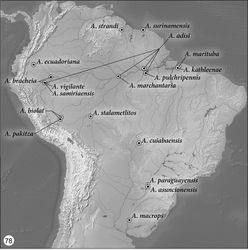Asklepia
Contents
- 1 Taxonavigation
- 2 Name
- 3 Type species
- 4 Derivation of genus name
- 5 Proposed english vernacular name
- 6 Dispersal potential
- 7 distribution
- 8 Way of life
- 9 Notes
- 10 Included species
- 11 geminata species group taxa
- 12 hilaris species group taxa
- 13 pulchripennis species group taxa
- 14 Key to the species of Asklepia Liebke, 1938
- 15 Taxon Treatment
- 16 Images
- 17 Other References
| Notice: | This page is derived from the original publication listed below, whose author(s) should always be credited. Further contributors may edit and improve the content of this page and, consequently, need to be credited as well (see page history). Any assessment of factual correctness requires a careful review of the original article as well as of subsequent contributions.
If you are uncertain whether your planned contribution is correct or not, we suggest that you use the associated discussion page instead of editing the page directly. This page should be cited as follows (rationale):
Citation formats to copy and paste
BibTeX: @article{Erwin2014ZooKeys430, RIS/ Endnote: TY - JOUR Wikipedia/ Citizendium: <ref name="Erwin2014ZooKeys430">{{Citation See also the citation download page at the journal. |
Ordo: Coleoptera
Familia: Carabidae
Name
Asklepia Liebke, 1938 – Wikispecies link – Pensoft Profile
- Asklepia Liebke, 1938:113
Type species
Asklepia strandi Liebke, 1938:113.
Derivation of genus name
Asklepius, a Greek God of healing. Why Liebke used this name is unknown. See: http://www.mythologydictionary.com/asclepius-mythology.html
Proposed english vernacular name
Neat pattern-wing beetles.
Diagnosis (Figs 29–55, 57–75). Size range – ABL = 1.95 mm to 3.74 mm; with the attributes of the genus Asklepia as described by Liebke (1938)[1]. Adults with head and pronotum smooth and shiny; elytron quadrangular, apically truncated, margin slightly oblique, pattern coloration with pale maculae (slightly flavotestaceous in some individuals); labial palpomeres pubescent, ultimate article globose basally and subulate apically; legs testaceous; basal antennomeres fulvous, medial antennomeres infuscated, apical antennomeres white (the number of basal, medial, and apical antennomeres is described for each species below). Abdominal sterna sparsely pubescent.
Species are arrayed across three species groups based mainly on the armature of the male aedeagal endophallus: geminata species group (endophallus without spines, Fig. 57), hilaris species group (endophallus with multiple spines, Figs 58–63), and pulchripennis group (endophallus with two spines, Figs 64–74). In addition, the species of the geminata species group have elytral striae and moderately convex intervals; the hilaris group members have explanate lateral margins on the pronotum while those of the pulchripennis groups are feebly beaded only in the anterior half.
Dispersal potential
The wings are fully developed in most individuals we have studied, thus it is likely that these beetles are moderate to strong flyers; however, in at least two species there are also brachypterous adults. This is unusual in lowland Amazonian species; for example, see Adis et al. (1997 [1998])[2] on a species of an odacanthine near Manaus, Brazil.
Geographic
distribution
(Figs 76–78). As currently known, the range of this genus extends in cis-Andean South America from southeastern Colombia south to Bolivia and east to Guyana and Belém, Brazil, and from there south to Entre Ríos Province, Argentina.
Way of life
These species live close to water in wet leaf litter and on aquatic vegetation (macrophytes) of backwashes along rivers, streams, and lakeshores of both Varzea and Igapó forests and among dead leaf accumulations on rocky or sandy stream banks. Immature stages are unknown; however, given the wide variation in adult size within a species as noted in the introduction, it is possible that larvae are ectoparasitoids (cf. Erwin 1967[3], 1979[4]; Frank et al. 2009[5]).
Notes
Not much has been previously published on this genus. We now know there are many undescribed species across the Amazon Basin and on the Guiana Shield and the southern part of the Brazilian Shield; hence it is not monobasic as reported by Reichardt (1974)[6]. Bates (1871)[7] actually described four species (assigned herein to Asklepia) placing them in the genus Eucaerus LeConte, none of which were recognized previously as an Asklepia species (cf. Liebke 1938[1]; Reichardt 1974[6]). Since the genus was in need of taxonomic revision, we have provided it here. Many areas of South America have not been sampled for very small water-side beetles; thus, it is likely many more species of this genus will be discovered in the future. As pointed out recently (Erwin et al. 2010[8]), many very tiny-sized carabid clades have gone mostly unnoticed. In the 1930’s, the discovery of Gehringia olympica Darlington served to adjust the search image of carabidologists toward a fractal universe smaller than previously used; however, such search image needs to be focused more in the rainforests of the world.
Included species
The species list below, as well as arrangement of descriptions that follows, is ordered alphabetically.
geminata species group taxa
Asklepia geminata (Bates), 1871:78, new combination, Brazil, Perú
hilaris species group taxa
Asklepia campbellorum Zamorano & Erwin, sp. n., Brazil
Asklepia demiti Erwin & Zamorano, sp. n., Brazil
Asklepia duofos Zamorano & Erwin, sp. n., Brazil
Asklepia grammechrysea Zamorano & Erwin, sp. n., Perú
Asklepia hilaris (Bates), 1871:79, comb. n., Brazil
Asklepia laetitia Zamorano & Erwin, sp. n., Colombia
Asklepia lebioides (Bates), 1871:79, comb. n., Brazil
Asklepia matomena Zamorano & Erwin, sp. n., Brazil
pulchripennis species group taxa
Asklepia adisi Erwin & Zamorano, sp. n., Brazil, Perú
Asklepia asuncionensis Erwin & Zamorano, sp. n., Paraguay
Asklepia biolat Erwin & Zamorano, sp. n., Perú
Asklepia bracheia Zamorano & Erwin, sp. n., Perú
Asklepia cuiabaensis Erwin & Zamorano, sp. n., Brazil
Asklepia ecuadoriana Erwin & Zamorano, sp. n., Ecuador
Asklepia kathleenae Erwin & Zamorano, sp. n., Brazil
Asklepia macrops Erwin & Zamorano, sp. n., Argentina
Asklepia marchantaria Erwin & Zamorano, sp. n., Brazil
Asklepia marituba Zamorano & Erwin, sp. n., Brazil
Asklepia pakitza Erwin & Zamorano, sp. n., Perú
Asklepia paraguayensis Zamorano & Erwin, sp. n., Paraguay
Asklepia pulchripennis (Bates), 1871:79, comb. n., Brazil
Asklepia samiriaensis Zamorano & Erwin, sp. n., Perú
Asklepia stalametlitos Zamorano & Erwin, sp. n., Bolivia
Asklepia strandi Liebke, 1938:113 Guyana
Asklepia surinamensis Zamorano & Erwin, sp. n., Surinam
Asklepia vigilante Erwin & Zamorano, sp. n., Perú
Key to the species of Asklepia Liebke, 1938
Note. Because of the variability within species and the marked similarity across some species, only features of the male genitalia provide reliable means for identification of some species. Unfortunately, we did not have at our disposal males of all the species to image.
Taxon Treatment
- Erwin, T; Zamorano, L; 2014: A synopsis of the tribe Lachnophorini, with a new genus of Neotropical distribution and a revision of the Neotropical genus Asklepia Liebke, 1938 (Insecta, Coleoptera, Carabidae) ZooKeys, 430: 1-108. doi
Images
|
Other References
- ↑ 1.0 1.1 Liebke M (1938) Denkschrift über die Carabiden-Tribus Colliurini. Festschrift zum 60. Geburtstage von Profesor Dr. Embrik Strand 4: 37–141.
- ↑ Adis J, Amorim M, Erwin T, Bauer T (1998) ) On ecology, life history and survival strategies of a wing-dimorphic ground beetle (Col. Carabidae: Odacanthini: Colliuris) inhabiting central Amazonian inundation forests. Studies on Neotropical Fauna and Environment 32: 174–192.
- ↑ Erwin T (1967) Bombardier beetles (Coleoptera: Carabidae) of North America: Part II. Biology and behavior of Brachinus pallidus Erwin in California. The Coleopterists Bulletin 21(2): 41–55.
- ↑ Erwin T (1979) A review of the natural history and evolution of ectoparasitoid relationships in carabid beetles. In: Erwin T Ball G Whitehead D Halpern A (Eds) Carabid Beetles: Their evolution, natural history, and classification. Proceedings of the First International Symposium of Carabidology. Dr. W. Junk b.v., Publishers, The Hague, 479–484.
- ↑ Frank J, Erwin T, Hemenway R (2009) Economically Beneficial Ground Beetles. The specialized predators Pheropsophus aequinoctialis (L.) and Stenaptinus jessoensis (Morawitz): Their laboratory behavior and descriptions of immature stages (Coleoptera, Carabidae, Brachininae). ZooKeys 14: 1–36. doi: 10.3897/zookeys.14.188
- ↑ 6.0 6.1 Reichardt H (1974) The systematic position of Asklepia Liebke, 1938, with a description of a new species (Coleoptera, Carabidae). The Coleopterists Bulletin 28(4): 177–179.
- ↑ Bates H (1871) Notes on Carabidae, and descriptions of new species (No. 7). Entomologist’s Monthly Magazine 8: 77–81.
- ↑ Erwin, T, Toledano, L, Maddison D (2010) New enigmatic species of ground beetles from stream margins and scree in the Andes of South America (Carabidae: Trechitae: Andinodontis gen. n.). In: Klaudnitzer B Schmidt J Erwin T (Eds) Contributions to Biology and Systematics of Beetles. Entomologische Blätter für Biologie und Systematik der Käfer (2010) 106, 73–88.













